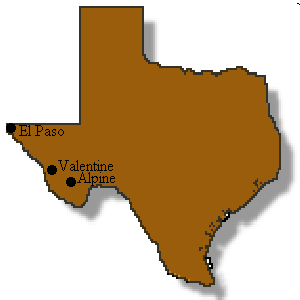


Although earthquakes are not common in the El Paso area, El Pasoans have felt a few notable tremors.
On May 3, 1887, a major earthquake registering more than 7.0 on the Richter scale occurred near Bavispe, Sonora, Mexico. Everyone in El Paso felt the shock. Buildings shook, cracks formed in walls of buildings, large safe doors swung open, plaster fell from walls and ceilings. Several buildings were so badly damaged that they had to be condemned. Many people were so frightened that they ran outdoors or even jumped out of windows.
On August 16, 1931, the town of Valentine, just southeast of El Paso, was rocked by a quake that measured 6.5 on the Richter scale. This is the largest quake measured in Texas in historic times. In El Paso, chairs moved, lights swayed, and some people left buildings out of fright.
Although the 1985 Mexico City quake was not felt in El Paso, several people experienced water loss in their swimming pools due to large waves.
In 1994 a series of minor earthquakes rocked the West Texas community of Alpine. Although they were not felt in El Paso, some minor damage was reported in Alpine due to the Richter 4.0 quake.
There are many active faults in the El Paso area, especially on the east side of the mountains. The Franklin Mountains continue to rise while the Hueco Bolson sinks. On average, an earthquake in the 3.0 to 4.0 magnitude occurs in El Paso every 10 years. The last such quake occurred on December 8, 1972 (magnitude of 3.0) near the Texas-New Mexico border in Northeast El Paso.
Geological evidence seems to show that a major quake occurs along the Franklin Mountains every 5000 years or so.
The total amount of energy released by an earthquake is called magnitude. The Richter scale, named for Charles Richter, is used to measure the relative sizes of earthquakes.
An increase of 1 in magnitude on the scale indicates the release of 10 times the energy of the next lower number. That means that an earthquake with a magnitude of 7 releases 10 times as much energy as an earthquake with a magnitude of 6.
Now, based on the above information, how much more energy was released in the 1887 quake at Bavispe, Sonora than the 1972 El Paso quake? Click on your answer.